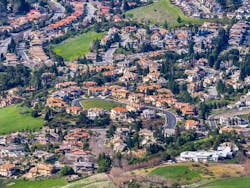More Power Outages in California? No Big Deal for Fremont Fire Department
Utilities in California are pre-emptively turning off transmission lines that could spark wildfires, but residents of Fremont can sleep a little more soundly knowing that the city’s microgrids will be there.
About two years ago, Fremont installed microgrids at three of its fire stations. At the time, the city was interested in getting clean and renewable power and felt that the battery integration would provide for additional utility bill savings as well as energy resiliency, said Rachel DiFranco, the city’s sustainability manager.
If the fire stations are threatened by a planned outage — known as a public safety power shutoff (PSPS) — “we would not have to worry about the facilities with microgrids as they are designed to automatically cut over to an ‘islanding’ mode in the event of a grid outage,” DiFranco said.
Fremont’s microgrids not only serve as backup power when the surrounding grid goes down, but they also supply most of the power for three of the city’s fire stations, either from the microgrid’s solar panels or the batteries that the solar panels charge when they produce more power than the fire stations can immediately use.
The city buys the power under contract from Gridscape, a company based in Fremont that installed, owns and operates the microgrids. Fremont signed the power purchase agreement with Gridscape in mid-2016 and deployed the microgrids in December 2017. Each microgrid is composed of a 40-kW solar array with a 110-kWh battery energy storage system.
Microgrids cut costs by half
In addition to keeping the lights on and reducing its greenhouse gas emissions, the microgrids also save the city money.
“We are paying half the price for each kilowatt hour generated by the microgrids as we do for grid power,” DiFranco said. Fremont estimates the microgrids will save the city $250,000 over 10 years.
It is harder the calculate the benefit of having backup power for critical services such as fire stations, but with the prospect of more PSPS events to come, that benefit is attractive to Fremont.
Fremont looks to install more microgrids
“The city is very much interested in identifying opportunities for microgrids at other critical municipal facilities, as well as helping identify other sites in the community that provide critical services,” DiFranco said.
She said Fremont is working closely with the city’s local energy provider, East Bay Community Energy, to identify potential sites.
…the phones at Gridscape are “humming. This is prime time for us.” — Vipul Gore
“We also have a grant through the Bay Area Air Quality Management District to explore opportunities for utilizing existing or new solar PV systems and pairing those with battery storage to support the electrification of municipal fleet vehicles as well as provide clean, renewable backup power for critical facility operations,” she said.
Providing microgrids for the fire stations was a demonstration project funded through a California Energy Commission (CEC) grant. The three fire stations were chosen for their good solar access, available space for battery storage and because they had the largest electricity bills, DiFranco said.
The three microgrids cost Fremont $2.4 million of which the commission contributed $1.8 million through its grant program for microgrids. Gridscape financed the remaining $600,000 and plans to earn back its investment through the power purchase agreement with Fremont, said Vipul Gore, president and CEO of Gridscape.
Often critical facilities have backup power, usually diesel generators, but what people often fail to realize, says Gore, is that it can be difficult to replenish fuel supplies when power is out. Street lights don’t work, so traffic slows or comes to a halt, and gas pumps don’t work.
Gridscape building 25 more microgrids
The project’s funding was part of a larger, $4.9 million grant from the CEC that Gridscape won in 2018 to build microgrids focused on grid resilience and disaster readiness. The company is in the process of building microgrids in Richmond, Stockton and other cities around the state. Some of the funding will come from the CEC grant, but Gridscape has also teamed up with “several financier partners,” who are funding systems with long-term agreements with offtakers, Gore said.
“We have about 25 microgrids under construction right now, all over in California,” he said;
Those sites include three hotels, two city halls, six fire stations, four police stations, as well as several community centers, schools and commercial buildings agricultural businesses.
Faced with the realities of the state’s PSPS program, Gore says the phones at Gridscape are “humming. This is prime time for us.”
Track news about California’s power shutoffs. Subscribe to the free Microgrid Knowledge newsletter.
